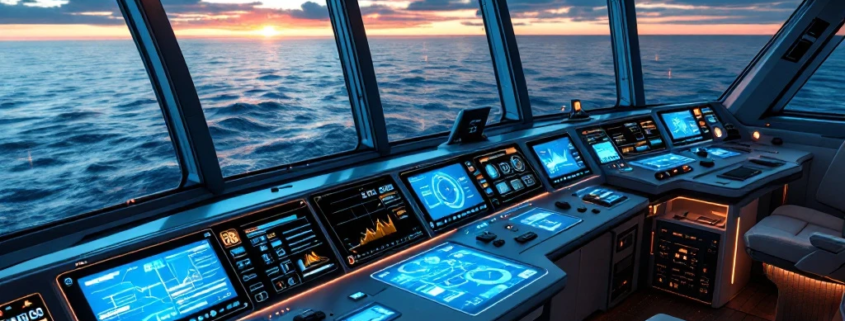What Innovations Are Transforming Marine Automation?
The maritime industry is experiencing a profound technological revolution through advanced marine automation systems. From intelligent control networks to sophisticated bridge integrations and autonomous capabilities, these innovations are reshaping vessel operations worldwide. The convergence of digitalization, regulatory pressures, and sustainability requirements has accelerated development of smarter, more efficient marine technologies. These advancements promise improved safety, reduced operational costs, enhanced environmental performance, and optimized crew efficiency across commercial shipping, passenger vessels, and specialized marine operations.
What is driving innovation in marine automation today?
The marine sector is undergoing unprecedented technological transformation, propelled by several converging factors. Stringent international regulations from organizations like the International Maritime Organization (IMO) are pushing vessel operators to adopt more sophisticated control and monitoring systems to meet emissions standards and safety requirements.
Operational efficiency demands represent another powerful catalyst. With fuel costs and crew expenses constituting major expenditures, shipping companies are seeking automation solutions that optimize route planning, reduce fuel consumption, and streamline operations with fewer personnel while maintaining safety standards.
Sustainability objectives have become increasingly crucial, as the maritime industry faces pressure to reduce its environmental footprint. Advanced automation systems enable precise fuel management, emissions monitoring, and performance optimization that support these environmental goals.
Finally, the broader digital transformation sweeping across industries has reached maritime operations. Connectivity improvements, data analytics capabilities, and integration possibilities have created opportunities for comprehensive vessel management platforms that were previously impossible.
How does CAN bus technology improve vessel operations?
CAN (Controller Area Network) bus technology serves as a foundational element in modern marine automation architecture. This robust communication protocol allows multiple electronic control units and systems to interact through a shared digital network, dramatically reducing the need for complex point-to-point wiring harnesses that were once standard in vessel construction.
The reliability of CAN bus networks is particularly valuable in the harsh marine environment. The protocol includes built-in error detection capabilities and ensures message delivery even in challenging conditions with electromagnetic interference, vibration, and temperature fluctuations that are common aboard vessels.
System scalability represents another significant advantage. CAN bus networks can accommodate additional equipment and sensors incrementally without requiring complete redesigns of the vessel’s control infrastructure. This adaptability is crucial as vessels upgrade technologies throughout their operational lifecycle.
By enabling seamless data sharing between propulsion systems, navigation equipment, power management modules, and auxiliary systems, CAN bus technology creates an integrated vessel nerve system that enhances operational awareness and control capabilities while reducing overall system complexity.
What benefits do integrated bridge systems offer for maritime operations?
Integrated bridge systems (IBS) represent a revolutionary approach to vessel management by consolidating numerous navigation, communication, and control functions into unified interfaces. This integration eliminates the traditional fragmentation of bridge equipment and creates a more cohesive operational environment.
Safety enhancements stand as the primary benefit, as these systems present critical information in contextually appropriate ways, reducing cognitive load on operators and decreasing the likelihood of human error. Integrated alert management ensures that warnings are properly prioritized and presented without overwhelming the crew during critical situations.
Operational efficiency improves substantially through workflow optimization that reduces task duplication and streamlines routine procedures. Information from radar, electronic chart display and information systems (ECDIS), automatic identification systems (AIS), and vessel management systems becomes accessible through coordinated interfaces rather than separate consoles.
Decision support capabilities represent another valuable aspect of integrated bridge systems. By correlating data from multiple sources, these systems provide crews with enhanced situational awareness and recommended actions based on comprehensive vessel status, navigational conditions, and operational parameters.
How are autonomous systems changing the marine industry?
The emergence of autonomous capabilities is revolutionizing maritime operations along a spectrum of automation levels rather than an immediate shift to crewless vessels. Beginning with advanced decision support systems that enhance human operations, the industry is progressively implementing higher levels of autonomy for specific functions.
Navigation assistance technologies now incorporate artificial intelligence to interpret sensor data from radar, lidar, cameras, and other sources to maintain collision avoidance capabilities that exceed human perception in many conditions. These systems continuously analyze surroundings to identify potential hazards and recommend optimal courses.
Remote operations represent an intermediate step toward fuller autonomy, where vessels maintain crews but can be monitored or controlled from shore-based facilities when appropriate. This approach balances the benefits of automation with the flexibility of human intervention.
Operational efficiencies from autonomous systems extend beyond navigation to include optimized route planning, fuel consumption management, and predictive maintenance that anticipates equipment failures before they impact vessel operations. These advances are changing crew requirements, with greater emphasis on technical oversight and system management rather than traditional maritime roles.
What challenges must be overcome for successful marine automation implementation?
Despite their transformative potential, marine automation technologies face several significant implementation hurdles. Cybersecurity concerns have become particularly critical as vessels become more connected. The integration of operational technology with information systems creates potential vulnerabilities that must be addressed through comprehensive security frameworks and regular updates.
Integration with legacy systems presents substantial technical challenges, as many vessels operate with equipment spanning different generations of technology. Creating functional interoperability between modern automation components and existing systems requires careful planning and specialized interface development.
Crew training requirements represent another crucial consideration. Even the most sophisticated automation systems require properly trained personnel who understand both the capabilities and limitations of the technology. Developing appropriate training programs and certification standards is essential for safe implementation.
Regulatory compliance adds complexity to automation adoption, as maritime authorities continue developing frameworks to address novel technologies. Vessels often operate internationally, requiring compliance with multiple regulatory regimes that may have different requirements for autonomous or highly automated systems.
Key takeaways: The future of marine automation innovation
The trajectory of marine automation clearly points toward increasingly integrated, intelligent vessel systems that enhance safety while reducing operational costs and environmental impact. The convergence of reliable communication networks like CAN bus with advanced control algorithms and comprehensive bridge systems creates vessels that are more efficient, safer, and more sustainable.
For maritime operators navigating this technological transformation, partnering with experienced automation specialists offers significant advantages. We at TK Engineering combine deep domain expertise in CAN bus technology and control systems with practical implementation experience across diverse marine applications.
As the industry continues its evolution toward more autonomous capabilities, our focus remains on developing reliable, scalable solutions that address real operational challenges in the maritime sector. By implementing appropriate automation technologies, vessel operators can position themselves advantageously for a future where digital integration, environmental performance, and operational efficiency become increasingly crucial competitive factors in the global maritime industry.
Interested in marine automation and control systems?
Browse our marine case studies to see how we support safe, efficient operations in harsh marine environments through smart CAN networking.



